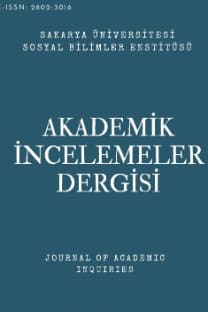Fiyat Düzeyinin Belirlenmesinde Yeni Yaklaşımlar ve Türkiye Deneyimi
Bu çalışma, Türkiye’de 1987:1-2004:4 dönemi enflasyon sürecinin, Sargent-Wallace (1981) “Nahoş Parasalcı Aritmetik” çalışması ve Fiyatın Mali Teorisi (Fiscal Theory of Price Level, FTPL) doğrultusunda yeniden değerlendirilmesini amaçlamaktadır. Belli koşullar altında, parasalcı aritmetiğin yanıltıcı olduğu belirtilen Sargent-Wallace (1981) yaklaşımında, para arzının bütçe kısıtını sağlama amacı doğrultusunda içsel olarak belirlendiği öne sürülmektedir. FTPL yaklaşımı ise, kamu açıklarının enflasyonist etkisinin para otoritesinin politikasını değiştirmeye zorlanmasından değil, borç krizlerinden doğduğunu ifade etmektedir.Bu doğrultuda, para arzı, bütçe açıkları ve enflasyon arasındaki dinamik ilişkiyi analiz etmek amacıyla VAR modellerinden faydalanılmış ve enflasyonist süreçte para arzı yanı sıra bütçe açıklarının da etkili olduğu görülmüştür.Çalışmanın genel sonucu, Türkiye’de ele alınan dönemde enflasyonun hem mali hem de parasal kaynaklı bir olgu olarak değerlendirilebileceği, dolayısıyla da enflasyonu önlemeye yönelik politikaların şekillendirilmesinde, para ile maliye politikalarının bir arada ele alınması gerekliliğidir.
Anahtar Kelimeler:
Parasal büyüme, bütçe açıkları, enflasyon, nahoş parasalcı aritmetik, fiyatın mali teorisi
Fiyat Düzeyinin Belirlenmesinde Yeni Yaklaşımlar ve Türkiye Deneyimi
In this study, the inflationary process of Turkish economy has been reinvestigated by using a quarterly data set spanning from 1987:Q1 to 2004:Q4. The approaches of “Unpleasant Monetarist Arithmetic” due to Sargent-Wallace(1981) and the Fiscal Theory of Price Level (FTPL) due to Woodford (1995) have been utilized in the study. The approach of the Sargent-Wallace’s theory claims that, under certain conditions, monetary arithmetic is misleading and the money supply is endogenously determined to sustain the budget constraint. However, according to the FTPL, the inflationary effects of the government budget deficits are caused by debt crises since the monetary authority does not haveto act to balance the budget deficit. To investigate the dynamic relationship among the money supply, budget deficit and inflation empirically, VAR models have been employed. Estimation results show that money supply and budget deficit statistically signicant effect on inflation in Turkey. Empirical analysis performed in the study leads to result that inflation in Turkey has both monetary and fiscal origins. From this result, it can be inferred that a policy design to combat with inflation, monetary and fiscal dimensions should be handled all together.
Keywords:
Monetary Growth, Budget Deficits, Inflation, Unpleasant Monetarist Arithmetic, Fiscal Theory of Price Level,
___
- BARTH J., IDEN G., RUSSEK F., “The Economic Consequences of Federal Deficits: An Issues”, Southern Economic Journal, 1987
- CHRISTIANO J. Lawrence, FITZGERALD J. Terry, “Understanding the Fiscal Theory of the Price Level”, nber:7668,2000
- COCHRANE H. John, “Long-term Debt and Optimal Policy in the FTPL”, nber:6771,
- COCHRANE H. John, “Money as Stock:Price Level Determination With No Money Demand”, nber:7498, 2000
- DORNBUSCH Rudiger , FISCHER Stanley, “Macroeconomics”, McGraw- Hill International Editions, Economics Series, 1990
- ERDOĞDU Oya, ÖZBEK Levent, “Türkiye’de Tüketim Eğilimi ve Maliye Politikası”, 2005 http://eros.science.ankara.edu.tr
- GONZALO Jesus, “Five Alternative Methods of Estmating Long-Run Equilibrium Relationships”, Journal of Econometrics,vol:60, 1994
- KOCHERLAKOTA Narayana, PHELAN Christopher, “Explaining the Fiscal Theory the Minneapolis Quarterly Review, Fall,1999
- ÖZAKTAŞ DAVARCIOĞLU Fatma, “Sürekli Bütçe Açıklarından Enflasyona: Türkiye Üzerine Uygulamalı Bir Çalışma” , Yayınlanmamış DoktoraTezi, Ankara Üniveristesi Sosyal Bilimler Enstitüsü, , ÖZMEN Erdal, KORU TEKİN Ayça, “Budget Deficits, Money Growth and Inflation:The Turkish Evidence”, Applied Economics,35,2003
- RAMANATHAN Ramu, “Introductory Econometrics with Applications”, The Dryden Press, 1992
- SARGENT Thomas,WALLACE Neil, “Some Unpleasant Monetarist Arithmetic”, Federal Reserve Bank of Minneapolis Quarterly Review,1981
- SIKKEN Jan and HAAN de Jakob, “Budget Deficits, Monetization and Central Bank Independence in Developing Countries”, Oxford Economic 50,1998 Papers
- SIMS A. Christopher, “A Simple Model for Study of the Determination of the Price Level and Policy”, Economic Theory, 4, 1994 the Interaction of Monetary and Fiscal
- TABELLINI Guido and ALESINA Alberto, “Voting on the Budget Deficit”, American Economic Review,March,1990
- UYGUR Ercan, “25 Yıldır Süren Yüksek Kronik Enflasyon ve Enflasyonla Mücadele, Hedefler Tutturulabilecek mi?”, İşletme Finans,Şubat UYGUR Ercan, “Enflasyon, Para ve Mali Baskı: İktisat Politikasında Geri Kalmışlık” İşletme Finans Dergisi, sayı:189,Aralık 2001
- WOODFORD Michael, “Doing Without Money:Controlling Inflation in a Post Monetary World”, Review of Economic Dynamics ,vol.1, 1998
- WOODFORD Micheal, “Fiscal Requirements for Price Stability” , Journal of Money, Credit and Banking, vol.33, no:3,August 2001
- WOODFORD Micheal, “Price Level Determinacy Without Control of Monetary Aggregate” , nber:5204, 1995
- WOODFORD Micheal, “Control of the Public Debt:A Requirement for Price Stability”, nber:5684,1996
- TELATAR Erdinç, “Para ve Maliye Politikası Dominant Rejimlerde Fiyat Belirlenemezlik Problemi ve Merkez Bankası Bağımsızlığı”, Ekonomik Yaklaşım, Cilt 10, Sayı:35, Kıs 1999
- DANIEL C. Betty, “Fiscal Policy and Inflation”, 2001 (a) www.frbsf.org/publications/economics/letter/2001
- Yayın Aralığı: Yılda 2 Sayı
- Başlangıç: 2006
- Yayıncı: Sakarya Üniversitesi Sosyal Bilimler Enstitüsü
Sayıdaki Diğer Makaleler
Risk Toplumunda (Depremle) Yaşamak
Beden Eğitimi Ve Spor Bölümü Öğrencilerinin Bilgisayar Kullanma Yeterlilikleri
Güneydoğu Terör Olaylarının Ekonomik Sonuçları
Şennur SEZGİN, Necmi GÜNDÜZ, Selami SEZGİN
Gültekin Yıldız, Hatice ÖZUTKU, Esin CEVRİOĞLU
Küreselleşme Çağında Bir Aidiyet Zemini Ve Örgütlenme Şekli Olarak Hemşehrilik
Küreselleşme Sürecinde Ekonomik, Ekolojik ve Toplumsal Riskler
Karahanlı Eserlerindeki Söz Varlığı Hakkında
Özel Çevre Koruma Bölgeleri Yönetim Sorunları Kapsamında: Pamukkale Özel Çevre Koruma Bölgesi
Avrupa Birliği İklim Değişikliği Politikasında Yeni Bir Politika Aracı: Emisyon Ticareti
Fiyat Düzeyinin Belirlenmesinde Yeni Yaklaşımlar ve Türkiye Deneyimi
